Study the role of garrisons in the Bible to uncover stories of divine strategy and human courage in ancient conflicts.
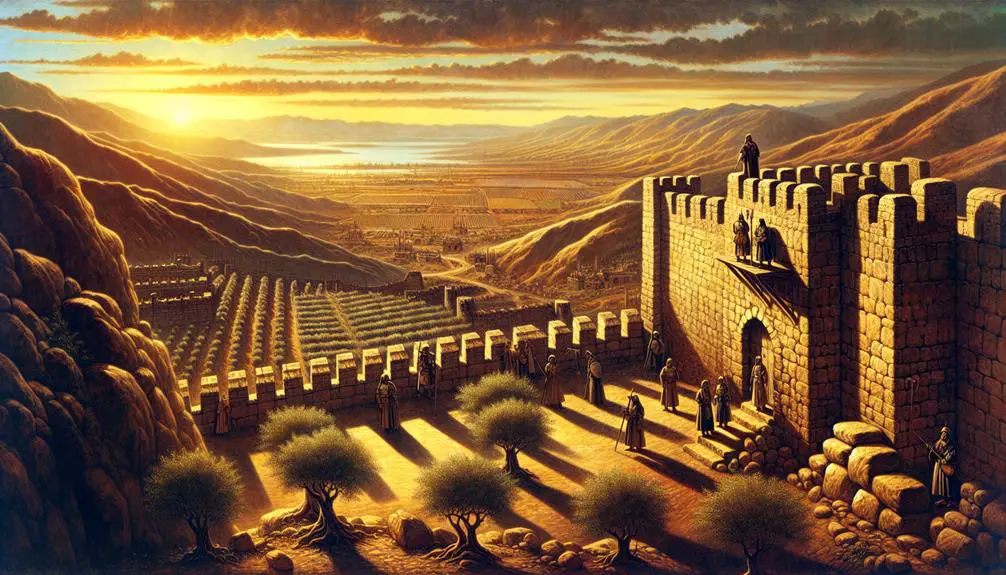
Garrison in the Bible
Like the walls of Jericho that fell to a divine strategy, garrisons in the Bible hold tales of warfare, faith, and divine intervention.
You might find yourself intrigued by how these military strongholds played pivotal roles in ancient conflicts and narratives.
From the historical context of their construction to the spiritual lessons they impart, the study of biblical garrisons reveals layers of meaning in sacred texts.
As you explore, consider how these ancient fortifications reflect on divine strategy and human leadership.
The intersection of archaeology and theology may offer insights that resonate even in modern reflections on faith and conflict.
Key Takeaways
- Garrisons played a crucial role in maintaining the security and stability of ancient Biblical territories.
- The strategic placement of garrisons reflected broader military and geopolitical strategies of the time.
- Prophets influenced military decisions, including garrison positioning, blending spiritual and physical defense mechanisms.
- Archaeological evidence and biblical narratives highlight the significance of garrisons in ancient military and spiritual leadership.
Understanding Biblical Garrisons
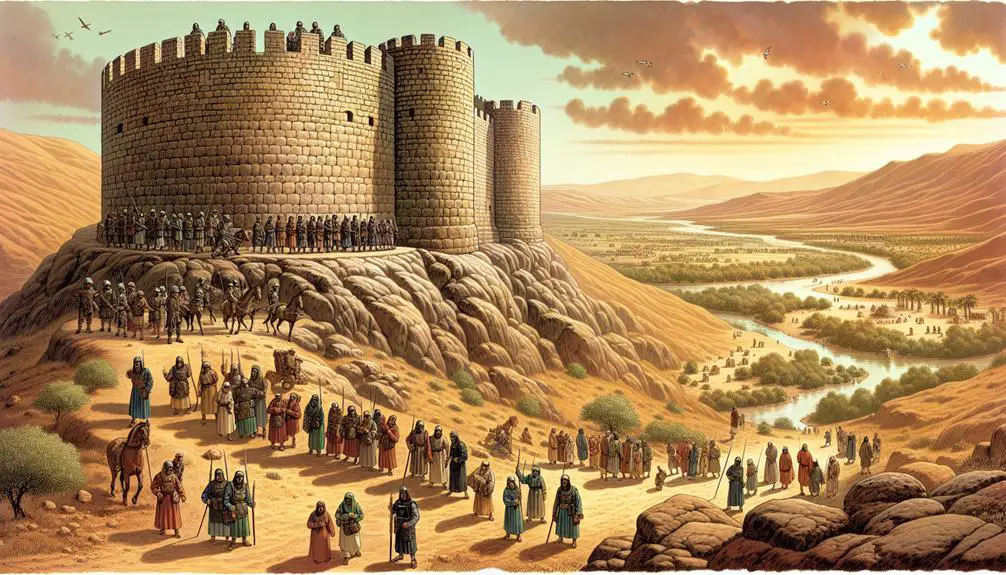
To grasp the concept of biblical garrisons, it's essential to examine their historical and textual significance within the context of ancient Near Eastern military strategies. The garrison lifestyle and economics played pivotal roles in these strategies, shaping the social and economic landscapes of the regions they occupied.
Garrison lifestyle was marked by discipline and regimentation, reflecting the militaristic nature of these establishments. Soldiers stationed at these outposts lived in a structured environment, with their daily routines governed by the demands of maintaining security and readiness for combat. This lifestyle not only influenced the soldiers' personal lives but also impacted the local communities, introducing a hierarchical system within the civilian population.
Garrison economics, on the other hand, revolved around the sustenance and financing of these military outposts. The economic model of garrisons involved the allocation of resources for the upkeep of soldiers and the maintenance of military facilities. This necessitated a steady flow of provisions, which often came from the local populace, either through taxation or requisition. Consequently, garrisons became economic hubs, fostering trade and commerce but also imposing financial burdens on the surrounding communities.
Understanding these aspects of garrison life and economics provides insight into their significance in the biblical context, revealing how they influenced both military strategies and societal structures in ancient times.
Historical Context of Garrisons
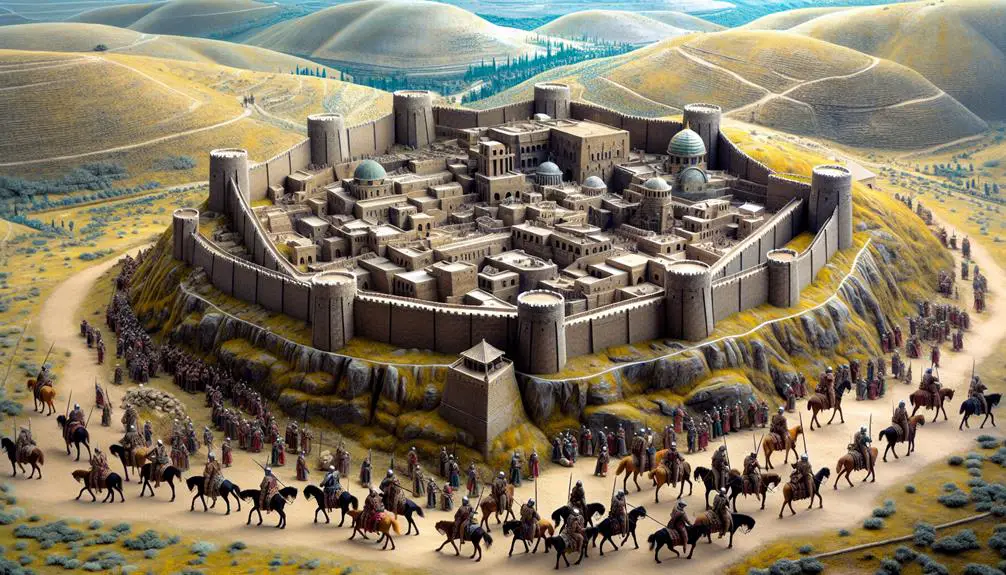
To understand the role of garrisons in biblical narratives, you must consider their ancient functions, the locations mentioned in biblical times, and how their use as military strategies evolved.
These elements shed light on the socio-political and military landscape of the era, offering insights into the strategic importance of garrisons.
Through analyzing these points, you gain a comprehensive view of how garrisons influenced both the physical and narrative battles within the Bible.
Ancient Garrison Functions
Understanding ancient garrison functions requires recognizing their central role in maintaining the stability and security of territories throughout biblical times. These fortified structures, pivotal in ancient military strategy, weren't merely about defense but also about asserting control and influence over strategic locations.
- Garrison logistics ensured effective supply chains for food, weapons, and reinforcements, critical for prolonged occupancy.
- Garrison architecture was designed for both defense and sustainability, incorporating features like thick walls, watchtowers, and secure water sources.
They served as administrative centers, facilitating local governance and the collection of taxes.
Garrisons acted as deterrents against potential aggressors, symbolizing the power and presence of the ruling authority.
In this context, garrisons were indispensable in the ancient world, embodying the intersection of military might and administrative governance.
Biblical Times Locations
Where did garrisons in biblical times strategically position themselves to exert control and ensure stability across ancient territories? You'll find that these locations were not randomly chosen but were pivotal in maintaining the cultural significance and showcasing the architectural styles of the era.
Location |
Significance |
|---|---|
Jerusalem |
A central hub for political and religious power, reflecting diverse cultures. |
Jericho |
Demonstrated military might and strategic importance in border control. |
Samaria |
Served as a symbol of resilience and cultural integration. |
Megiddo |
Its architectural prowess highlighted the strategic planning in warfare. |
Bethlehem |
Showcased the intertwining of cultural heritage with military necessity. |
This tableau offers a glimpse into how garrisons were more than mere military installations; they were integral in shaping the landscape and cultural fabric of biblical times.
Military Strategy Evolution
Garrisons evolved significantly over time, reflecting broader shifts in military strategy and the geopolitical landscape of biblical territories. As you dive deeper, you'll notice the sophistication in their approach:
- The introduction of better fortification techniques to protect garrisons against sieges.
- Enhanced training for garrison troops, focusing on specialized roles, including siege tactics.
- Adoption of naval warfare strategies, recognizing the strategic importance of controlling waterways.
- Evolution of siege tactics, moving from mere encirclement to more complex operations involving towers and battering rams.
This evolution underscores a dynamic period in military history, where adaptability and innovation were paramount. The changes in garrison strategies weren't just about defense but also about exerting control, power, and influence across the biblical landscapes, reflecting the complex interplay of warfare, politics, and religion during those times.
Key Biblical Battles and Garrisons
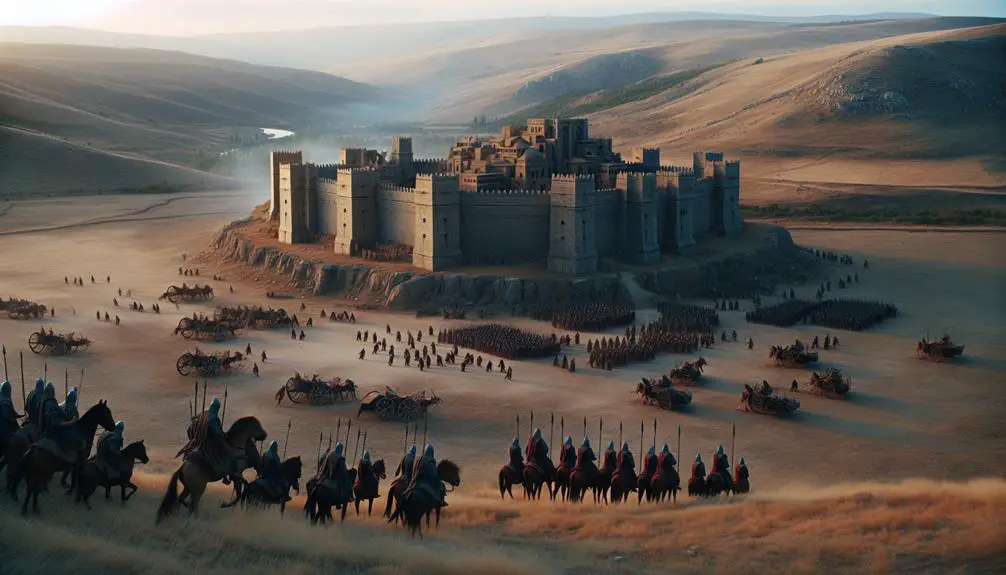
Throughout the biblical narrative, several pivotal battles and garrisons play a crucial role in shaping the historical and spiritual landscape of the ancient Near East. These confrontations between kingdoms and peoples not only altered territorial boundaries but also marked significant transitions in leadership and divine favor.
One such example is Saul's downfall, where strategic missteps and the failure to maintain his garrison led to his defeat and death. This pivotal moment underscores the importance of military preparedness and divine guidance in achieving victory.
In contrast, David's stronghold represents a masterful use of garrison strategy, bolstering his position both militarily and spiritually. By securing strategic locations and fortifying his defenses, David not only expanded his territory but also solidified his claim to the throne. His understanding of the terrain and the effective use of garrisons allowed him to outmaneuver his adversaries, highlighting the significance of tactical acumen in biblical warfare.
These instances illustrate how battles and garrisons weren't mere physical confrontations but were deeply intertwined with the divine will and the unfolding of God's plan for His people. They remind us that in the biblical narrative, victory often hinged on faith, strategy, and the wise use of resources.
Garrisons and Divine Strategy

You'll find that garrisons in biblical narratives often symbolize divine protection, serving as physical manifestations of God's safeguarding of chosen peoples or lands.
This concept is further enriched by examining the strategic placement of these garrisons, offering lessons on the importance of positioning and foresight in achieving divine purposes.
Through this lens, the role and location of garrisons not only reflect military tactics but also divine strategy in biblical history.
Divine Protection Roles
How does the concept of divine protection manifest within Biblical narratives, particularly through the strategic deployment of garrisons? In the scriptures, divine protection is often portrayed through both angelic intervention and protective miracles, showcasing a multifaceted approach to safeguarding the faithful.
This divine strategy is evident in several key aspects:
- *Angelic intervention* provides direct, sometimes invisible, protection and guidance.
- Protective miracles defy natural laws, marking divine presence and intervention.
- The use of garrisons symbolizes God's strategic placement for defense.
- Instances of divine warnings and guidance act as preemptive measures to avert danger.
These elements together illustrate a comprehensive divine strategy for protection, blending the supernatural with tangible measures to ensure the safety and guidance of believers.
Strategic Placement Lessons
In examining the strategic deployment of garrisons within the Bible, one observes a profound alignment with divine strategy, emphasizing the importance of positioning in both physical and spiritual defenses. The concept of a garrison mentality and its role in siege warfare highlights a critical aspect of ancient and divine tactics: the deliberate placement of forces to secure territories and instill a sense of security against spiritual and physical adversaries.
Aspect |
Biblical Example |
Strategic Lesson |
|---|---|---|
Location |
Jericho |
Importance of strategic positioning |
Preparation |
Nehemiah's rebuilding of walls |
Readiness and fortification |
Faith |
David vs. Goliath |
Divine favor in seemingly unfavorable positions |
Leadership |
Moses leading Israelites |
Guidance and vision in maneuvering |
Persistence |
Siege of Samaria |
Sustained effort and trust in divine providence |
This table encapsulates the nuanced interplay between divine guidance and strategic human action, underscoring the timeless lessons embedded within biblical narratives.
The Role of Prophets and Garrisons
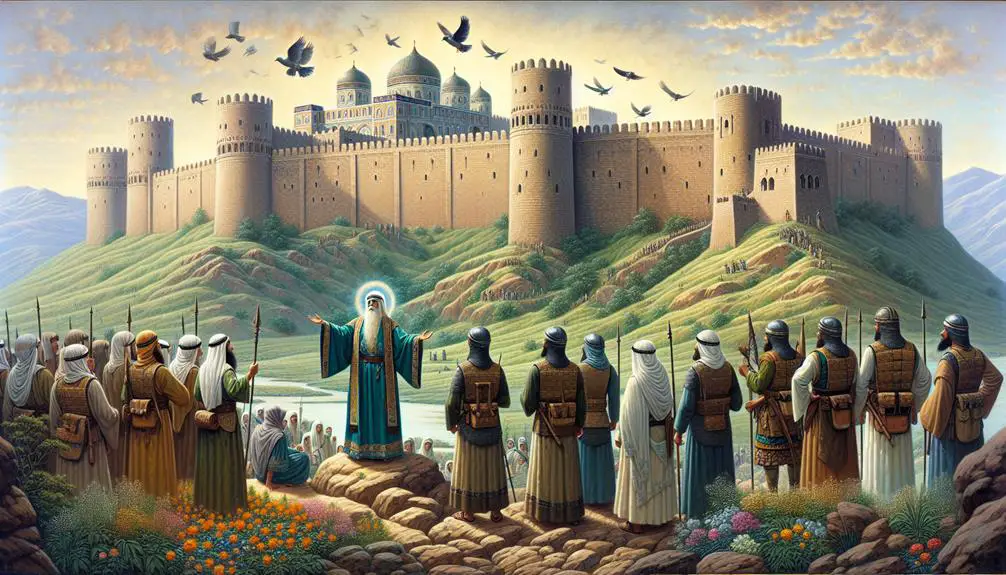
Prophets and garrisons played pivotal roles in the biblical narrative, each serving distinct functions within the spiritual and military frameworks of ancient societies. While prophets delivered prophetic messages and divine warnings, garrisons ensured the physical security of these societies. This dual approach played a crucial role in the maintenance of both spiritual order and physical safety.
- Prophets served as intermediaries between the divine and the people, often conveying critical messages that guided or warned the society in times of moral and spiritual crisis.
- Garrisons, on the other hand, were physical structures or military posts that provided defense against external threats, ensuring the safety and stability of a territory or city.
- The interplay between prophetic guidance and military strength was vital. Prophets often influenced the decisions of military leaders, with their divine warnings sometimes dictating the strategic positioning of garrisons.
- This relationship underscored a broader theme in the biblical narrative: the balance between spiritual faithfulness and practical, worldly measures to protect and sustain the community.
Understanding the roles of prophets and garrisons highlights how ancient societies navigated challenges through a combination of divine guidance and tangible, military strategies.
Archaeological Evidence of Garrisons

What does the archaeological record reveal about the presence and structure of ancient biblical garrisons?
Digging into the layers of the past, you find that the evidence of garrison architecture isn't merely anecdotal but substantial. Ancient fortifications, strategically located near vital routes or significant urban centers, underscore their importance in military and administrative operations. These structures, often characterized by robust walls, watchtowers, and gates, were designed to withstand sieges and provide safe havens for troops. The excavation sites, some undergoing meticulous garrison restoration, offer a glimpse into the complexity of these military installations.
You'll notice that the layout of these garrisons wasn't random but followed a strategic blueprint that maximized defense capabilities and ensured control over surrounding territories. The archaeological findings, including remnants of barracks, armories, and other support buildings, highlight the sophistication of military engineering in biblical times. Through careful analysis, you can piece together the daily life within these garrisons, understanding not just their military significance but their role in the broader socio-political landscape of the ancient Near East.
Spiritual Lessons From Ancient Garrisons

While examining ancient garrisons, one can uncover profound spiritual lessons that echo through time, teaching us resilience, preparedness, and the importance of strategic spiritual defenses. These fortified structures, manned by vigilant guards, serve as metaphors for the spiritual vigilance required in our lives. The leadership within these garrisons and the morale of their inhabitants offer insightful parallels to the spiritual journey.
- Strategic spiritual defenses: Just as ancient garrisons were strategically placed to protect against physical threats, we must position our spiritual defenses against life's challenges. This involves constant vigilance, prayer, and the study of sacred texts to fortify our spirits.
- Garrison leadership: The leadership within a garrison dictated its success or failure. Similarly, spiritual leadership in our lives, whether it be from religious figures, mentors, or personal conviction, guides us through moral and ethical dilemmas.
- Garrison morale: The morale within the walls of a garrison could determine its resilience in the face of siege. In our spiritual lives, maintaining a positive outlook and faith during trials reflects this principle of inner strength.
- Community and support: Just as garrisons relied on the collective efforts of their inhabitants for defense, our spiritual journey is bolstered by the support and fellowship of a like-minded community.
These lessons underscore the timeless relevance of ancient wisdom in guiding our spiritual resilience and preparedness.
Modern Reflections on Biblical Garrisons

Reflecting on biblical garrisons, you'll find that their historical and spiritual significance offers valuable insights into contemporary faith practices and communal defense mechanisms. In the ancient context, garrisons weren't just military outposts but also symbols of protection, power, and ethical control. Garrison morality, a concept derived from these historical functions, underscores the importance of moral fortitude and community defense against not just physical but also spiritual and ethical invasions.
In today's society, the lessons from biblical garrisons extend beyond physical defense to advocate for peaceful coexistence and moral vigilance within communities. You're invited to consider how these ancient strategies for safeguarding territories can be metaphorically applied to protect personal and communal values against modern-day challenges. The principle of garrison morality encourages you to build strong, resilient communities grounded in ethical principles and mutual respect.
Moreover, the concept of peaceful coexistence, extracted from the strategic placement and purpose of biblical garrisons, promotes the idea that security and peace aren't mutually exclusive but can be achieved simultaneously through wisdom, understanding, and cooperation. This perspective offers a foundational strategy for navigating contemporary social and spiritual conflicts, emphasizing the significance of both protection and peace in fostering a harmonious community.
Frequently Asked Questions
How Do Modern Military Strategies Compare and Contrast With the Concept of Garrisons as Described in the Bible?
When comparing modern military strategies to historical garrison concepts, you'll notice that fortification technology has dramatically evolved. Modern defenses leverage advanced materials and surveillance, a stark contrast to ancient stone walls and towers.
However, the importance of troop morale remains a constant. High morale boosts a garrison's effectiveness, both then and now.
It's this psychological aspect that bridges ancient and contemporary military practices, highlighting a timeless element in warfare strategies.
Can the Presence of Ancient Garrisons in Biblical Times Be Linked to the Development of Specific Cities or Regions in the Contemporary Middle East?
Just as seeds grow into towering trees, ancient garrisons have shaped today's Middle Eastern cities.
You'll find their roots not just in the soil of history but in the very fabric of modern urban landscapes.
Their presence, once pivotal for defense, now marks areas of profound religious significance and economic impact.
Analyzing these sites sheds light on how strategic military decisions have sculpted the region's development, weaving a rich tapestry of cultural and societal evolution.
How Have Different Translations of the Bible Affected the Interpretation of Passages Related to Garrisons?
Different translations of the Bible have significantly influenced how passages regarding garrisons are interpreted. With varying translation methodologies and the linguistic evolution over centuries, you'll find that nuances in language can alter the meaning and perception of these texts.
This evolution in understanding reflects in the scholarly analysis of biblical passages, where the choice of words and their contemporary interpretations can shift the context and insight into historical and theological discussions.
What Role Did Women Play in the Context of Biblical Garrisons, if Any, According to Extra-Biblical Historical Sources?
Diving into history's depths, you'll find that women's roles, particularly in military contexts, are often overlooked. Through textual analysis of extra-biblical historical sources, it's clear that women had significant, if not widely recognized, roles within these settings.
Their contributions, from support to direct engagement, challenge traditional narratives and shed light on broader issues of women's rights. This scholarly exploration underscores the importance of revisiting and reevaluating historical interpretations to fully appreciate women's contributions.
How Have Biblical Scholars Reconciled Discrepancies Between Archaeological Findings and Biblical Accounts Regarding Ancient Garrisons?
To reconcile discrepancies between archaeological findings and biblical accounts, scholars often turn to textual criticism and archaeological methodology.
They meticulously compare ancient texts with physical evidence, aiming to understand the historical context better. This analysis helps them piece together a more accurate narrative of the past.
Conclusion
In the tapestry of sacred narratives, garrisons stand as silent sentinels, whispering of divine strategies and human courage. These fortified havens, embedded in the rugged landscapes of antiquity, not only recount tales of conflict and conquest but also of divine guidance and prophetic wisdom. Through the lens of archaeology and scripture, they offer us a glimpse into the intricate dance between the celestial and the earthly.
As we reflect on these ancient strongholds, we're reminded of the enduring lessons they hold for navigating the battlegrounds of our own lives.



Sign up